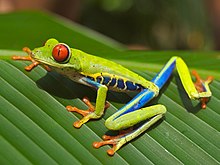Agalychnis callidryas
- For another frog called the red-eyed treefrog, see Litoria chloris
Agalychnis callidryas, commonly known as the red-eyed tree frog, is a species of tree frogs.
| Red-eyed treefrog | |
|---|---|
 | |
| Scientific classification | |
| Domain: | Eukaryota |
| Kingdom: | Animalia |
| Phylum: | Chordata |
| Class: | Amphibia |
| Order: | Anura |
| Family: | Phyllomedusidae |
| Genus: | Agalychnis |
| Species: | A. callidryas |
| Binomial name | |
| Agalychnis callidryas (Cope, 1862) | |
 | |
| Red-eyed Treefrog range[2] | |
 | |
| Larger scale[2][3] | |
| Synonyms | |
| |
Red-eyed tree frogs spend most of their time on large tropical leaves. They are not poisonous, and rely on camouflage to protect themselves. During the day, they stay still, cover their blue sides with their back legs, tuck their bright feet under their stomachs, and shut their red eyes. So they look almost completely green, and are well hidden amongst the leaves.[4] The large red eyes are a defensive adaptation called deimatic behaviour. When a red-eyed tree frog detects a predator, it abruptly opens its eyes and stares at the predator. The sudden appearance of the red eyes may startle the predator, giving the frog a chance to flee.[4]
They are active at night. They like to eat small insects.
During mating, the female carries the male on her back for several hours during the process. The female chooses a leaf above a pond or large puddle on which to lay her clutch of eggs. The male puts out his sperm onto the eggs as they are released.
Tree frogs lay jelly-like eggs. The mothers will stay near them and help them fight any hungry animals that want to eat them. They become a tadpole in one or two weeks. They drop from the leaf and into the lake which is below the leaf.
If predators are close enough to produce vibration, the embryos sense this. After a few seconds, they vigorously hatch out into tadpoles and spread out to escape.[5]
References

